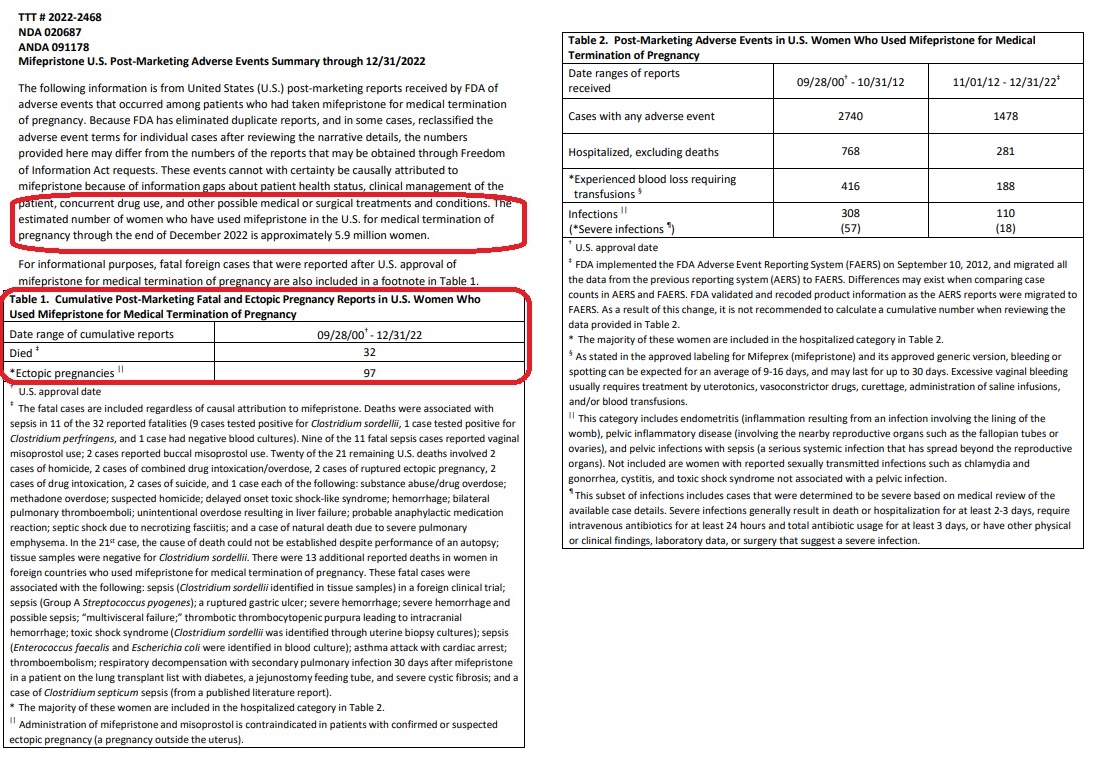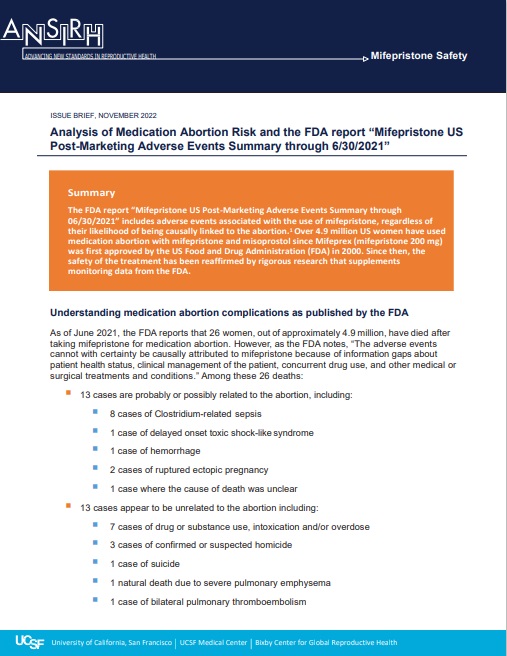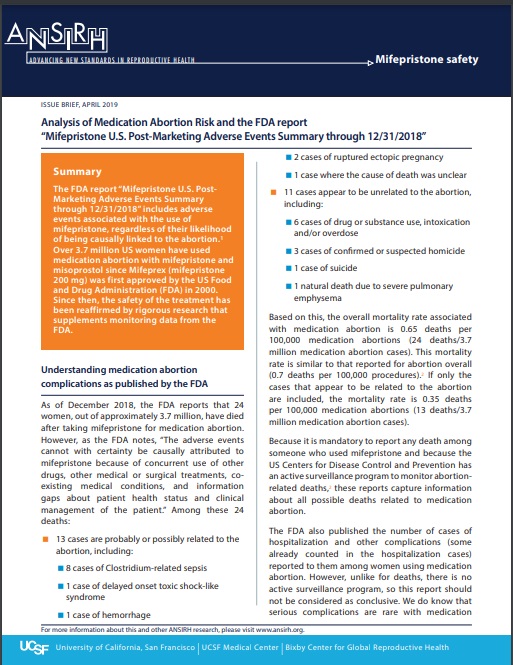Since 2000, the estimated number of women who have used the abortion pill mifepristone in the U.S. for “medical termination of pregnancy through the end of December 2022 is approximately 5.9 million women,” reported the Food and Drug Administration (FDA) earlier this month. This number represents potentially 5.9 million preborn human lives (at least) lost to abortion by the abortion pill regimen (mifepristone and misoprostol) since 2000, and is 300,000 more than what was previously reported in January through the end of June of 2022.
Some of these mothers may have sought help through the Abortion Pill Reversal (APR) hotline, which has claimed to help approximately 4,500 women successfully carry babies to term after taking the mifepristone.
Deaths Associated with the Abortion Pill
In addition to the increase in babies targeted by chemical abortion, the FDA reports 32 deaths “associated with mifepristone” since its approval in 2000.
“The FDA has received reports of serious adverse events in patients who took mifepristone. As of December 31, 2022, there were 32 reports of deaths in patients associated with mifepristone since the product was approved in September 2000, including two cases of ectopic pregnancy (a pregnancy located outside the womb, such as in the fallopian tubes) resulting in death; and several fatal cases of severe systemic infection (also called sepsis),” according to the updated numbers published on the FDA website on September 1, 2023.
“The adverse events cannot with certainty be causally attributed to mifepristone because of concurrent use of other drugs, other medical or surgical treatments, co-existing medical conditions, and information gaps about patient health status and clinical management of the patient,” the FDA also noted.
This is an increase of four (4) deaths since the last reported numbers in January 2023, and comes as abortion pill dispensing has been approved for expansion to mail-order pharmacies and brick-and-mortar pharmacies, where it is unlikely a medical professional will see the woman in person before she takes the drugs.

Abortion pill Mifepristone use and adverse events and deaths reported 2000 to December 31, 2022 to FDA
In 2022, 24-year-old Alyona Dixon allegedly died from “septic abortion” after she obtained the abortion pill from Planned Parenthood. The wrongful death lawsuit does not name Planned Parenthood as a defendant in the case. Instead, the lawsuit names as defendant the first emergency department she sought help from, because they “negligently failed to conduct a pelvic exam” on Dixon and “failed to order a consult with an OB/GYN despite [her] abnormal lab results, her clinical history, and her abnormal diagnostic imaging…” among other allegations.
It is unknown why did Dixon visited an emergency department instead of Planned Parenthood, where she obtained the drugs, but under current FDA safety requirements (REMS) on the abortion pill, prescribers of the drug must have the “Ability to diagnose ectopic pregnancies” and to “provide surgical intervention in cases of incomplete abortion or severe bleeding, or to have made plans to provide such care through others, and ability to assure patient access to medical facilities equipped to provide blood transfusions and resuscitation, if necessary.”
Number of Deaths Directly Related to the Abortion
According to the latest FDA report, “The fatal cases are included regardless of causal attribution to mifepristone. Deaths were associated with sepsis in 11 of the 32 reported fatalities (9 cases tested positive for Clostridium sordellii, 1 case tested positive for Clostridium perfringens, and 1 case had negative blood cultures). Nine of the 11 fatal sepsis cases reported vaginal misoprostol use; 2 cases reported buccal misoprostol use. Twenty of the 21 remaining U.S. deaths involved 2 cases of homicide, 2 cases of combined drug intoxication/overdose, 2 cases of ruptured ectopic pregnancy, 2 cases of drug intoxication, 2 cases of suicide, and 1 case each of the following: substance abuse/drug overdose; methadone overdose; suspected homicide; delayed onset toxic shock-like syndrome; hemorrhage; bilateral pulmonary thromboemboli; unintentional overdose resulting in liver failure; probable anaphylactic medication reaction; septic shock due to necrotizing fasciitis; and a case of natural death due to severe pulmonary emphysema. In the 21st case, the cause of death could not be established despite performance of an autopsy; tissue samples were negative for Clostridium sordellii.”
“There were 13 additional reported deaths in women in foreign countries who used mifepristone for medical termination of pregnancy,” the FDA also wrote.
While the FDA does not specifically state how many mifepristone-related deaths can be attributed solely to the abortion pill, previous research published by the pro-abortion group Advancing New Standards in Reproductive Health (ANSIRH) has suggested that as many as half of the FDA’s reported mifepristone deaths could be attributed to “the drug [mifeprostone]” and to “abortion.”
ANSIRH’s November 2022 analysis of mifepristone-related adverse events through June of 2021 claimed that “13 cases [out of 26 reported deaths] are probably or possibly related to the abortion, including:
▪ 8 cases of Clostridium-related sepsis
▪ 1 case of delayed onset toxic shock-like syndrome
▪ 1 case of hemorrhage
▪ 2 cases of ruptured ectopic pregnancy
▪ 1 case where the cause of death was unclear”

ANSIRH wrote that 26 women died from abortion pill
ANSIRH also listed a similar claim in an April 2019 analysis of the FDA’s 2018 adverse events report for mifepristone, where they wrote that “13 cases are probably or possibly related to the abortion” and that “11 cases appear to be unrelated to the abortion” (meaning 11 of the 24 total reported at that time). In addition to ANSIRH, claims published in an American College of Obstetricians and Gynecologists (ACOG) amicus brief in the case of Alliance for Hippocratic Medicine v. U.S. Food and Drug Administration also cited the same 13 abortion pill deaths statistic, sourcing it from ANSIRH’s April 2019 analysis.

ANSIRH claimed that 24 women died from abortion pill
ANSIRH was founded by abortionist Felicia H. Stewart and is funded by the Packard Foundation, which provided early financial assistance to the abortion pill’s U.S. manufacturer, Danco.
Adverse Events Reported To FDA
In addition to the deaths, the report shows 4,218 adverse events were reported, including 1,049 hospitalizations, 604 incidents of blood loss requiring transfusions, and 418 infections, of which 75 were serious. Under updates made in the 2016 REMS, the requirement that all adverse events be reported was removed by the FDA.
Since 2016, only deaths of which the abortion pill manufacturer Danco is made aware must be reported to the FDA. And since some abortion providers will suggest that women present to an emergency department rather than the abortion facility where the drug was purchased or claim that they are experiencing a natural miscarriage instead of a chemical abortion, it is possible that some related deaths may go unreported.
Today, the profitable abortion industry touts abortion drugs as safe and simple despite multiple conflicts of interest surrounding the studies, their authors, and even the testing sites and sponsors.
In addition, bad actors inside the abortion industry continue to flout the FDA’s REMS by ignoring the approved gestational limits or approved protocols for prescribing the abortion pill; leaving women to deal with ectopic pregnancies or not ruling them out prior to prescribing the drug; promoting an unapproved one-drug regimen of misoprostol only; dispensing abortion drugs to women who are not yet pregnant; and encouraging women to simply present to the emergency room, and claim a natural miscarriage when experiencing abortion pill related complications.
Abortion Pill Numbers
Abortions done by pill now make up the majority of all abortions committed in the United States — 53% in 2020 alone. And with the proliferation of unregulated online virtual abortion businesses, chemical abortion numbers are likely to grow. This number does not represent abortion pills being shipped into the country illegally.
Those who prefer chemical abortion over surgical or procedural abortion tend to be Asian or White, according to a recent survey, which showed that “individuals who identified as Asian or White, had no prior births or abortions, or were paying out of pocket were all more likely to have a medication abortion.”
“Non-Hispanic Black individuals, those with incomes at or below the poverty level, and those paying with insurance were more likely to have a procedural [surgical] abortion,” the survey claimed.
“Some 24% of respondents chose the facility because it offered medication abortion, but even after controlling for this proxy for method preference in a logistic regression model, Black respondents and those with poverty-level incomes were less likely to have a medication abortion,” the authors found.
As of August of 2023, while 13 states had near-total protections for preborn children in effect (Alabama, Arkansas, Idaho, Kentucky, Louisiana, Mississippi, Missouri, North Dakota, Oklahoma, South Dakota, Tennessee, Texas and West Virginia), Planned Parenthood’s former “special affiliate” the Guttmacher Institute reported that “15 states restrict access to medication abortion” in some capacity or another by requiring in-person visits, requiring only licensed physicians can prescribe the deadly drug, gestational limits, or banning mail order dispensing.








